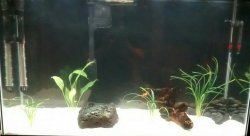Does the fact that my tap water is hard account for the jump in pH? I thought about using purified water for any further water changes, but didn't want to buy walmart out of it's water supply to do the initial filling of my tank. loldaizeUK said:
Ammonia, from "decomposing" (plants and fish poo -hehe), turns to nitrite, which turns to nitrate? So we are trying to level out the amount made so that there is a balanced/healthy cycle.. yes?.. - Don't laugh.. I just had my first child. She's 7months, and is absorbing my brain
I know exactly what you mean. It's true - babies absorb brains! Happened to me too.
The idea is to establish a colony of bacteria that will convert ammonia into nitrate, and another colony of bacteria that will convert nitrite into nitrate. Then you do regular water changes to remove the nitrate and keep the tank in balance - ta-da!
Sadly the Nutrafin cycle is unlikely to live up to its claims. I would advise that you follow the fishless cycling guide http/www.fishforums.net/index.php?/topic/421488-cycling-your-new-fresh-water-tank-read-this-first/ and use an ammonia source to cycle the tank.
There is quite a large jump in pH from your tap to your tank water. Mine increases from about pH 7.6 from the tap to 8.2 due to natural dissipation of CO2 but yours is quite a bit more severe. Take a sample of tap water and leave it to stand overnight, then test the pH. This will tell you the natural pH of your tap water after CO2 has dissipated. Any difference between that and your tank pH is due to something increasing the hardness of water in your tank.
The best way to oxygenate your water is to direct the filter flow up towards the surface to cause a ripple. If the surface is sufficiently agitated then you shouldn't need an airstone, although it won't do any harm if you want one.
Hope this helps,
Daize
I like the way you broke that down, but am curious. Is nitrate used by anything in the tank? Do the plants use it? Or do the small water changes help virtually eliminate it or lower the levels so that the cycle can continue stably?
My filter may be agitating the surface just fine then. It's flowing beautifully along the top at an almost complete horizontal angle and allowing for a stream like flow. I thought that it needed more aggressive agitation - involving bubbles and splashing (the fun stuff) lol
Darn this Nutricycle! I will go ahead and use it for tomorrows "dose", because that's all I have left of it
So I technically haven't even started the cycle! I'm laughing at myself.
Now I have to ask.. based on my tanks stats what amount of ammonia do I need to add to begin properly cycling?
Thanks so much for your kind response, btw!
-Phan.


